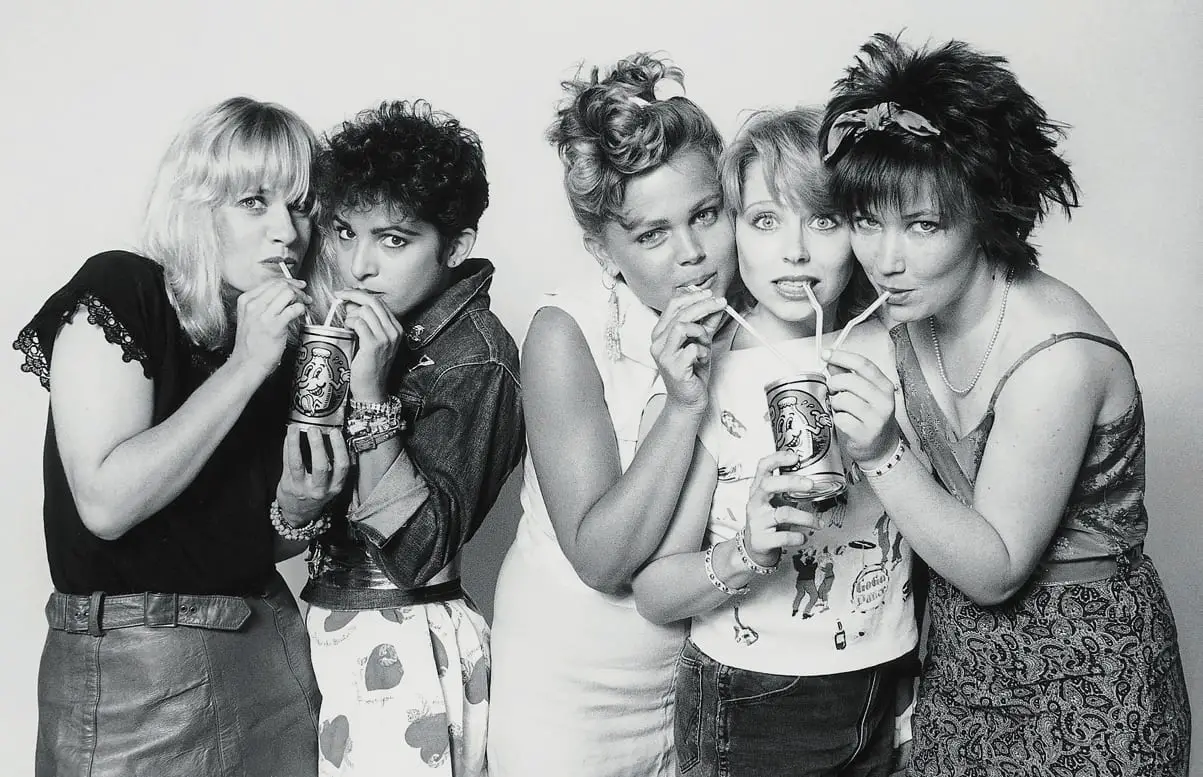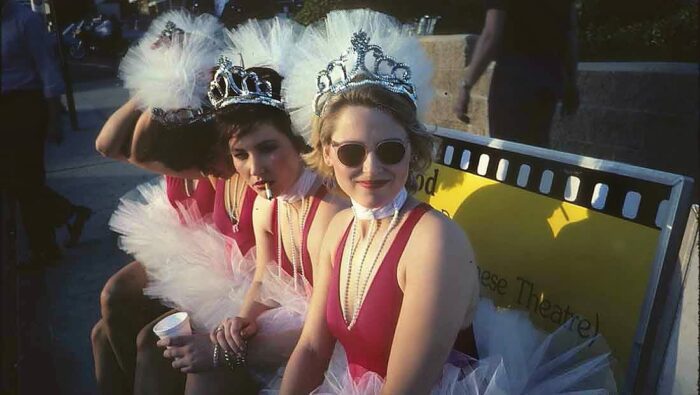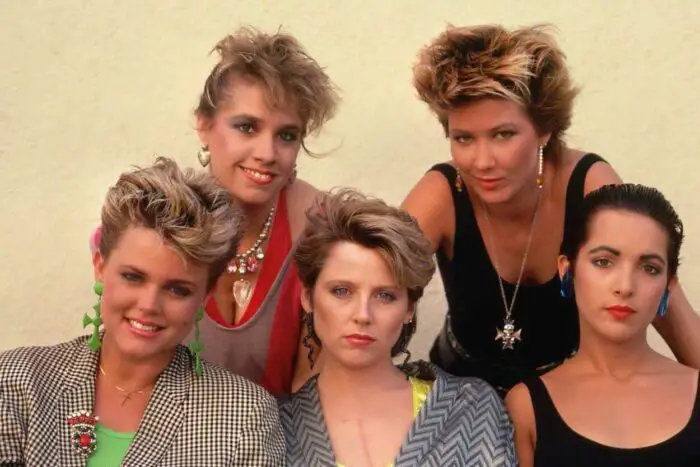People automatically assume that we were put together by some guy, but we did it all ourselves. – Belinda Carlisle in The Go-Go’s (2020)
We are living in the age of Taylor Swift, K Pop girl groups and as I write this Cardi B and Megan Thee Stallion are scoring high on the music charts with their raunchy but cheeky “WAP”. Whether it’s The Bangles or The Chicks (formally Dixie) or even Pussy Riot one all-female group conquered the charts with fortitude, spunk, energy, and immeasurable talent 40 years ago before any I just mentioned. That band was The Go-Go’s, now the subject of a new Showtime documentary.
One aspect of The Go-Go’s which has always been fascinating is how the band enjoyed three years of white-hot soaring success—and then at the height of it all, they broke up. The split happened just as they were arguably lyrically and musically as brilliant as they may have ever been as writers and performers. One only has to listen to their last release of the 1980s, Talk Show (especially the album’s Chuck Berry influenced opener “Head Over Heels”) to hear not just absolutely brilliant instrumental arrangements but each and every band member exhibiting newfound confidence in their abilities as performers especially compared to their ragged early dive bar performances.
Every group has an origin story and as origin stories go the Go-Go’s is a pretty uncomplicated one. The Go-Go’s were formed in 1979 in LA by regulars of the then growing LA punk scene, guitarist Jane Wiedlin, and vocalist Belinda Carlisle. The other early members of the band consisted of bassist Margot Olavarria and drummer Elissa Bello.
In Alison Ellwood’s sensational new documentary on the history of the band, all members are candidly interviewed including Bello and Olavarria. Nobody is left out. Everybody’s recollections of these early years are a treat to hear—even if a few of these participants haven’t laid eyes on others in 40 years.
The Go-Go’s first year as a group was very touch and well, go. Especially as the group began slowly breaking away from the punk attitude which brought them together in the first place. While they weren’t incorporating disco influences into their writing and performing in the same way as say Blondie was, they were embracing a less in-your-face, more LA style of cheery, candy-flavored pop as they evolved, much to the chagrin of Olavarria and Bello. Those two would leave the group due to differences in musical style. Gina Shock came on board as the band’s drummer and Charlotte Caffey of The Eyes joined as a guitarist. When bassist Kathy Valentine joined the group well, it was the perfect fit. These five spunky women, Belinda Carlisle, Jane Wiedlin, Charlotte Caffey, Gina Schock, Kathy Valentine, became The Go-Go’s and they changed pop music forever.

A good music (or movie) documentary is one that manages to depict a certain moment of time as well as its human subjects. Martin Scorsese’s 2006 Bob Dylan documentary No Direction Home is successful at showing the viewer what life was like during the years Dylan was growing up and the years when he had started to make a name for himself. Ellwood’s The Go-Go’s begins with LA in the very late ’70s just as the punk scene was finding its place. Wiedlin was especially taken with the punk scene as she explains in the film. Carlisle was also entranced by the punk movement going so far as to show up at a club wearing a trash bag as an outfit one night and being Belinda Carlisle she, of course, pulled it off.
As the band was finding their way in their formative year, their songwriting was key to connecting with audiences. What sealed (no pun intended) the group’s position as a group people should take notice of was their first hit “Our Lips Are Sealed” (a song Wiedlin wrote based on a love letter from Terry Hall, her then-boyfriend from punk/ska group The Specials) from their debut album Beauty and the Beat.
Released in the summer of 1981, Beauty actually didn’t become a hit until their second hit “We Got The Beat” (written by Caffey) began receiving radio play in early 1982. The band was the opening act for The Police that summer and a huge celebration was had in the band’s dressing room when Beauty hit #1 on the music charts. What followed was a notorious, coked-up performance on Saturday Night Live and a controversial Rolling Stone cover.
“Our Lips Are Sealed” and “Vacation” were staples of constant MTV airplay in 1982 and ’83. The “Our Lips Are Sealed” video was produced from $6000 of unused cash leftover from a Police shoot and was continuously aired on the newly launched MTV service, and everyone everywhere knew The Go-Go’s. With Beauty a chart-topping success the band was asked to perform all over the country while they were working on their follow-up album Vacation with its surf-rock bouncy beat making the group true rock stars.
While the band was experiencing the success they dreamed about nobody outside the group knew what was happening in the lives of these women. Keep in mind in 1982 there was no TMZ; there was no Oprah even. Aside from People magazine, nobody knew what our worshipped movie and rock stars were up to and the feeling one senses from the members of The Go-Go’s is that they thank their stars for it.
When the band made the cover of Rolling Stone Magazine in the summer of 1982 the covers tag line was “The Go-Go’s Put Out” which we learn in this film did not sit right with band members or then-manager, Ginger Canzoneri who personally phoned Rolling Stone editor-in-chief Jann Wenner to blast him (in typical Wenner fashion, he hung up on her). For whatever reason, Wenner put the group on the cover again just two years later with more pleasing results.
“Our Lips Are Sealed” has been featured in countless movies over the decades from Romy and Michele’s High School Reunion to 200 Cigarettes and TV shows such as Grey’s Anatomy. No doubt it has made that song’s writer Wiedlin very wealthy but eventually, as we here from the women here, the band was unsure of how to deal with certain members making more money by writing the songs while Carlisle and Schock especially were earning the least.

The Go-Go’s continued to write and performed their own material while each member’s role was assigned pretty early on—Carlisle on lead vocals, Wiedlin on rhythm guitar and songwriter, Caffey as a keyboardist, guitarist-songwriter, Schock on drums, and Valentine a bassist and songwriter. According to Wiedlin, Schock, and Valentine, the money was a major factor in the group’s tensions as were other members wanting to voice lead on specific songs which was rejected as Carlisle was the designated lead vocalist.
Money was not the only stress factor facing the band. In the film’s more candid revelations, Caffey recalls her struggles with a serious cocaine addiction for pretty much her entirety with the band. Caffey along with Wiedlin, wrote most of the band’s songs and one wonders if they came from out of a place of sheer talent, coke induced binges, or a combination of both. It wasn’t until near the end of the band’s journey that Caffey entered rehab and got sober.
Schock reveals the heart condition she was suffering from which required life-saving surgery in 1983 just as the band was working on their third album Talk Show. Schock emerged better than ever, but at that point tensions between the band members were at a fever pitch, and ultimately, the group was beyond saving.
Perhaps the doc’s most revealing member is co-founder Wiedlin who while bubbly, charming, witty and still adorable, carried most of the responsibility for keeping the band together. Because Wiedlin, Caffey, and Valentine were the core songwriters they of course earned more money. This was a source of serious conflict and resentment among the other members, particularly drummer Schock and lead vocalist Carlisle. In one painfully hilarious moment in the movie, Carlisle remembers the tension but still maintained how they were all like sisters to which Wiedlin quips “Yeah, sisters who stab each other in the fucking back.” For Wiedlin The betrayal is felt just as much today as it did 36 years ago.

The most popular single from Talk Show was “Head Over Heels” (written by Caffey and Valentine) but despite its high energy mix of pop and rock and immediately hooks the listener with an infectious beat the song’s lyrics give away the turmoil the five women were going through in just trying to remain together:
“Been running so long I’ve nearly lost all track of time, In every direction, I couldn’t see the warning signs, I must be losin’ it, ‘cause my mind plays tricks on me, It looked so easy but you know looks sometimes deceive.”
The Go-Go’s are all smiles and grins, and they dance and perform their hearts out as sisters in this video, but as Carlisle points out, looks sometimes do deceive. The same could be said of the “Turn To You” video which featured the band in oversize suits while a very young Rob Lowe stares/flirts at Caffey and then later makes out with Carlisle on a couch.
When Wiedlin wanted to sing a personal song she wrote for Talk Show titled “Forget That Day” she was refused. Carlisle was the singer, and there were no ifs and or buts around that. Wiedlin left The Go-Go’s not long after. The group brought on talented guitarist Paula Jean Brown to fill her role, but the magic was gone. The Go-Go’s called it quits in 1985 just as new female acts such as Cyndi Lauper and Madonna were conquering the pop charts (although this fact is not alluded to in The Go-Go’s).
But the band didn’t cut ties completely. Carlise recruited Wiedlin and Caffey to write material for her upcoming solo album Belinda. “Mad About You” was a smash hit in 1986 and Carlise’s Heaven on Earth was an even bigger hit the year after. It might have come as a shock to some to see the Carlise of “Mad About You” and “Heaven Is a Place on Earth” who once wore a trash bag to a gig adopt a more sophisticated and stylish appearance. In the Diane Keaton directed video for “I Get Weak” for example, the singer is decked out in glamourous satin outfits. Even former punker Wiedlin embraced a more mainstream appearance by wearing a black dress for her hit single “Rush Hour” in 1988. Wiedlin never reached the chart-topping success Carlisle did, but she was featured on the 1990 soundtrack to Pretty Woman which would go on to be certified triple platinum by the RIAA.
At the end of 1991, Carlisle attempted an even sexier image with “Do You Feel Like I Feel”, but her music failed to top the charts. In the summer of 1992 her label MCA released a greatest hits compilation which did fairly well however she reveals in this doc, she was dropped by the label in 1998 after turning 40 (Carlisle turned 62 the day I wrote this).
Ellwood’s documentary becomes more astonishing and absorbing as it goes on, primarily because of the candidness of these women. The only one who seems as if she’s always in “interview/performer” mode is Carlisle, but because she’s been “the face” of the Go-Go’s and has been so successful for so long as a solo artist in her own right, this is understandable.
One doesn’t even notice while watching the first time because the story is so compelling, but on second viewing the watcher will probably notice how close Ellwood’s camera is to her subjects. Eventually, they all stop speaking to the camera and on off-camera Ellwood and speak from within themselves.
I suppose if one went to Showtime to tell them they wanted to do a documentary on The Rolling Stones, for example, executives would imagine them being interviewed as a group. If you were to sit and watch The Go-Go’s expecting them to be interviewed together throughout you’d be disappointed but that disappointment would be short-lived. By interviewing all the members separately it is able to delve deeper into the feelings of all involved. The Go-Go’s may love each other but an hour and a half of watching any group of people sitting together saying “we love each other so much” is not that interesting especially when it comes to the dynamic personalities featured here.
Typical of rock documentaries is the formula we always see:
- Formation
- Early struggles
- Success
- Envy
- Fights/conflict
- Break up
- Reunite.
Yes, The Go-Go’s follows this formula but keep in mind, these are the actual members of the most successful female group in history telling their story. This isn’t a slightly dramatized Hollywood biopic. These women are as real and honest as one would hope them to be. Still, there are certain topics not covered such as Carlisle’s heroin addiction although to be fair, she wrote about this extensively in her autobiography.
It was a very wise decision just to feature core Go-Go’s performers and management (although Stewart Copeland of The Police is featured numerous times in this film). Ellwood does a remarkable job connecting the footage of early LA punk Go-Go to their London performances in front of white supremacists who looked like they were ready to jump the stage and murder these girls.
If there is one quibble I have with Ellwood’s terrific documentary is the time allotted between their 1985 breakup, and they’re reuniting in 1994, 2001, and now in 2020. I would have liked to have seen a little more exploration about the members during their Go-Go free years. According to Carlisle, a number of them didn’t even speak to each other for five years.
In 1994 the band reunited and released a double-disc compilation Return To the Valley of the Go’Go’s which included the new single “The Whole World Lost Its Head.” The Go-Go’s were back, but the ’90s were much different. Nirvana and grunge groups were the musical style that year. Mariah Carey had become the top female singer of the time, and ’80s performers such as Madonna and Whitney Houston (riding high from The Bodyguard soundtrack) were the performers dominating CD sales.
The Go-Go’s just couldn’t strike it hot as they did 12 years prior. However, their influence was still everywhere. Can.you imagine a Salt N Pepa without The Go-Go’s or En Vogue or The Dixie Chicks and yes, even the most popular ’90s girl band The Spice Girls existing if it wasn’t for the subjects of this article? These all owe a debt to The Go-Go’s for being the first-ever all-female band to 100% write and perform their own material.
Of the recent rock documentaries, I’ve seen including Taylor Swift’s Miss Americana, Lady Gaga’s Five Foot Two, and Joan Jett’s Bad Reputation, Ellwood’s The Go-Go’s is the one that excels above them all. Perhaps it’s because of my long-time fondness for the group; perhaps it’s the sense of history, friendship, and sisterhood that comes across from each of them here or maybe it’s because of the honesty each member displays.
The Go-Go’s is an unflinching warts-and-all movie about five incredible women who changed music and society forever without even trying. They weren’t political; they weren’t pissed off, they weren’t trying to shatter any glass ceilings—they just wanted to rock out and play their hearts out – which they did. They were looking for a family—which they found and they just wanted to be heard—which they were.
The Go-Go’s contains more truth and honesty in it than most big-budget studio produced rock bios and It’s by far one of the very best things I have seen this year. For a band who’s most popular hit song is one about keeping secrets, the members of the Go-Go’s prove to be some unfiltered, uncompromising and amazing storytellers.

